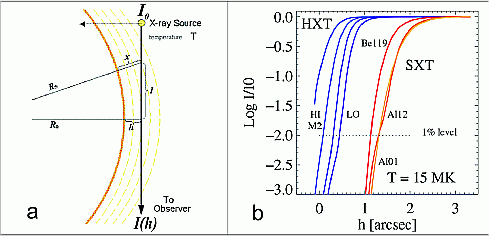MODELLING OF X-RAY SOURCE OCCULTATION
BY SOLAR DISK
Space Research Centre, Polish Academy of
Sciences, Kopernika 11, 51-622 Wroclaw, Poland
EXTENDED ABSTRACT
The aim of present research is to investigate the occultation of solar X-ray sources seen near and behind the edge of solar
disk. Understanding the occultation details allows for precise coalignment of deconvolved SXT images with sub-arcsec resolution in cases when the limb position can be used as the
reference, i.e. for flares being occulted by the limb. Accurate image coalignment
(down to 0.1 arcsec) is necessary in order to determine realistic maps of plasma temperature using filter ratio technique. Present results indicate also that a proper analysis of time history and apparent spectral evolution of sources located near the edge of solar disk need spectral influence of the occultation to be taken into account.
In our analysis, we assume that the bottom structure of solar atmosphere corresponds to one of the plane-parallel VAL models (Vernazza at. al., 1981). We assume that the X-ray source being occulted is point-like and its spectrum comes from the optically thin plasma of temperature T. We model the occultation as seen by the SXT and HXT instruments in all energy channels using the effective areas h(l) taken from the respective SolarSoft files.
In the solar context, the X-ray optical thickness is made up of two physical processes, eg. the absorption due to presence of 'metals' (sa) and Thomson scattering (sT) on free electrons (Klein-Nishina at higher energies). Using VAL-F model i.e. NH(r) and Ne(r) dependencies, we have calculated the energy (wavelength) dependent optical thickness along the path l [t(h,l) = 2ò0¥[sa(l) NH(h,l) + sT(l) Ne(h,l)] dl] (see the scheme in Figure 1a for definitions). We have calculated the spectra to be transmitted at the given height I(h,l) and the total signal I(h)/I0 = exp(-t) expected to be measured within individual SXT and HXT bands. In Figure 1b we show the results obtained for three SXT filters and all HXT bands for the source of T = 15 MK. Inspection of Figure 1b reveals that:
- The exact position of the öcculting" limb is slightly different for individual SXT filters and HXT bands. Among the SXT filters, the Be119 limb position is 0.3 arcsec below its location for the ''softer'' channels. The most ünusual" I(h)/I0 behaviour is observed for the Al12. This is related with a pronounced "two-bands" character of h(l) dependence for Al12 filter.
- The position of the öcculting" limb in HXT bands is about one arcsec below the respective SXT positions. However, the position of the öcculting" limb is still few hundred km (on the Sun) above the optical limb.
- The spectra observed become harder and harder as the source comes closer to the optical limb. These spectral hardening is related with a steep dependence of sa on the energy (sa ~ E-3; cf. Somov, 1975).
In accordance with (1), when coaligning the Al12 with Be119 deconvolved images using limb position as reference, mentioned correction should be used. This correction amounts to 0.1 arcsec for cooler and 0.3 arcsec for hotter sources respectively. From (1) and (3) it follows that the temperature of the source (as derived from Be119/A112 ratio) will rise as the source comes closer to the limb. For a source of temperature T = 15 MK, its filter ratio temperature would be 30 MK, at the height where Al12 intensity falls to half of I0 value. This effect is expected to give artificial, higher temperature edge at the position close to the occulting limb. The width of this edge is 0.2 - 0.4 arcsec (less than 1/5 of SXT pixel), and therefore would reveal on temperature maps derived from deconvolved images only. Based on results of the occultation phenomenon modelling it is possible to predict the shapes of light curves for sources evanescent from behind the limb. From SXT observations, it is seen that bright loop-top kernels usually rise with typical velocity of ~ 10 km/s. If such a rising source (assumed point-like) appears from behind the limb, we predict to see a specific pattern of light-curves for different bands of SXT and HXT. This pattern follows that presented in Figure 1b, if we apply a constant scaling factor of ~ 75 s/arcsec to the horizontal axis. As one may expect, the first signal to rise is that for hardest HXT channels, followed by SXT ones after ~ 70 s. The shape of lightcurve rise is similar for all bands (except Al12). Detailed modelling of the light-curves for real sources (somewhat extended and non-isothermal) emerging from behind the limb may allow for diagnostic of both the source dynamics and the temperature structure. The results obtained are independent of the atmosphere model considered, i.e. the location of the occulting edge is within 0.1 arcsec for any of the six solar atmosphere models considered in
VAL.

Figure 1:
a) Scheme of physical situation considered (as seen from above the ecliptic plane): the point-like X-ray flare kernel of temperature T, is observed near the limb, at the apparent distance h from optical edge of the disk, being partially occulted by the lower layers of solar atmosphere (not to scale).
b) The height dependence of intensity (I(h)/I0) due to absorption of X-ray source by solar atmosphere for HI, M1, M2 and L bands of HXT and Be119, Al12 and Al01 filters of SXT.
ACKNOWLEDGEMENTS
This work has been supported by Polish Committee for Scientific Research Grant 2.P03D.024.17. The authors would like to thank unknown Referee for the comments which led to substantial improvement of the present contribution.
References
-
Somov B.V., Solar Phys., 42, 235 (1975).
-
Vernazza J.E., E.H. Avrett & R. Loeser, Astrophys. J. Supp., 45, 635 (1981), [VAL].
BACK
File translated from TEX by TTH, version 2.25.
On 25 Mar 2002, 10:03.
